If you’re on the hunt for plants that thrive in shady spots, look no further! This guide introduces you to 34 shade garden plants that will brighten up those dim corners of your garden. Whether you’re looking for vibrant flowers, lush foliage, or low-maintenance options, these plants will help you create a thriving green oasis even in low light. Dive in and discover the perfect picks for your shaded spaces!
Lungwort: Charming Ground Covers

Lungwort is an attractive choice for shade gardens, as seen in the vibrant image above. It features lovely clusters of blue flowers that peek through lush green leaves. These little blooms add a delightful touch to any shady spot.
The plant thrives in moist, well-drained soil and works well to cover bare ground, making it an excellent option for those tricky, dimly lit areas in your garden. Its foliage is equally charming, with a texture and color that can brighten up a shady corner.
In addition to their beauty, lungworts are also low-maintenance. They don’t require much care and can spread to fill spaces over time. This makes them a smart choice for gardeners looking to add some life to their shade gardens without a lot of fuss.
Hostas: Versatile Foliage Varieties

Hostas are a popular choice for shady gardens, and it’s easy to see why. This image showcases a rich variety of hosta foliage, with shades of green and stunning variegation. Each leaf is unique, adding character to any garden space.
The bold greens provide a lush backdrop, while the lighter leaves with intricate patterns bring a splash of excitement. Whether you’re looking for solid colors or multi-colored varieties, hostas offer a lot of options to play with.
One of the best parts about hostas is their adaptability. They thrive in different soil types and are perfect for filling those tricky shady spots in your garden. And as they grow, they create lovely mounds of foliage that can really enhance your landscape.
Incorporating hostas into your garden design can create a calming and inviting atmosphere. Pair them with other shade-loving plants or unique garden ornaments for a personal touch. Remember, variety is key, and hostas fit the bill.
Astilbe: Colorful Flowering Powerhouses

Astilbe plants are a great choice for adding vibrant color to any garden. Their tall, feathery plumes come in shades of pink, white, and red, creating a lovely display. The image showcases the striking pink flowers, which stand out beautifully against the lush green foliage.
These plants thrive in shaded areas, making them ideal for spots where sunlight is limited. They not only add visual interest but also attract pollinators like bees and butterflies, enhancing your garden’s ecosystem.
Astilbe is easy to care for. Just ensure they have plenty of moisture, especially during the hot summer months. Regular watering will keep them looking fresh and full. Whether planted in clusters or as solitary specimens, they bring a cheerful touch to any landscape.
If you’re considering adding Astilbe to your garden, think about pairing them with ferns or hostas for a lush, layered effect. Their colorful blooms will brighten up the shady corners and create a peaceful retreat in your outdoor space.
Brunnera: Forget-Me-Not Alternatives

Brunnera, often known as Siberian Bugloss, shines in the garden with its vibrant blue flowers resembling the delicate forget-me-not. The image showcases a lush display of Brunnera’s heart-shaped leaves and clusters of bright blue blooms that add a splash of color to shady spots.
These plants thrive in partial to full shade, making them perfect for those tricky garden areas where sunlight is limited. The lush green foliage creates a lovely backdrop for the striking blue flowers, creating a peaceful atmosphere in your garden.
Brunnera is not just beautiful but also low-maintenance. Once established, they can spread slowly, forming a nice ground cover. Ideal for filling in gaps or softening edges, these plants work well alongside ferns and hostas, enhancing the overall look of your shade garden.
If you’re looking for a forget-me-not alternative, consider Brunnera for its striking appearance and ease of care. It’ll definitely bring joy and color to your garden space.
Heuchera: Colorful Leaf Varieties
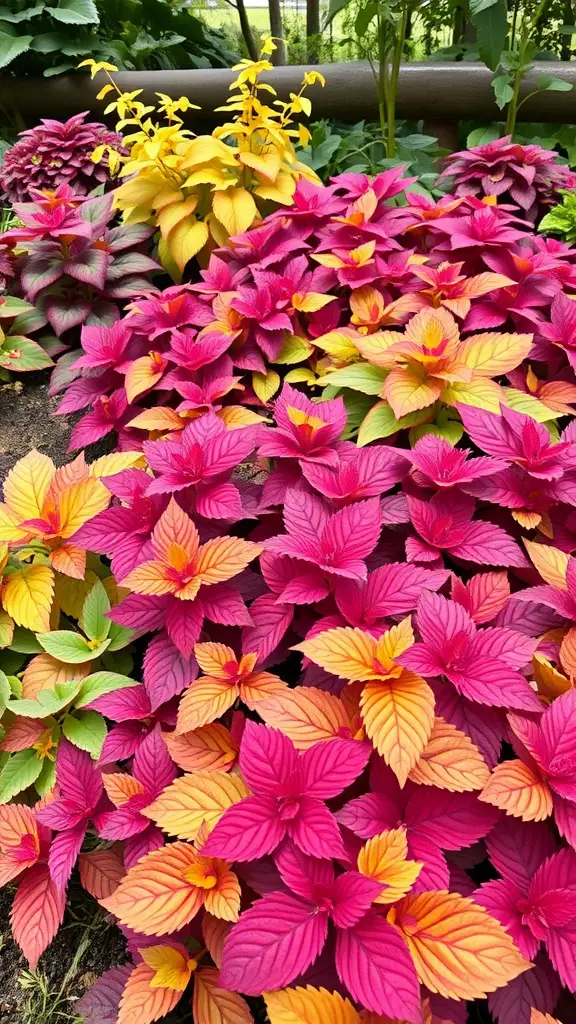
Heuchera, commonly known as coral bells, is a fantastic choice for adding vibrant colors to your shade garden. The image above showcases a stunning array of Heuchera plants, highlighting their colorful leaves in shades of pink, orange, and green.
These plants are not just pretty; they offer a diverse palette that brightens up shady spots. Their leaves come in different shapes and textures, making them a fun option for garden enthusiasts. The blend of colors you see creates a lively scene that can lift the mood of any garden.
Besides their beauty, Heuchera plants are quite hardy. They thrive in partial to full shade and are generally low-maintenance, which means you can enjoy their beauty without too much fuss. Whether you want to create a border or fill in bare patches, Heuchera is an adaptable choice that helps bring life to those darker areas.
Incorporate various Heuchera varieties into your garden for a colorful display throughout the seasons. With so many options available, there’s sure to be a perfect match for every style and preference.
Japanese Maples: Striking Focal Points

Japanese maples are truly a delight for any garden. Their vibrant foliage adds a splash of color, especially in the fall when the leaves turn a brilliant red. This particular tree showcases an impressive display of those fiery hues, making it a captivating focal point.
The tree stands tall, with its branches gracefully arching. This structure not only adds elegance but also provides a sense of tranquility. Surrounding plants complement its beauty, creating a harmonious balance in the garden.
Incorporating a Japanese maple can transform your outdoor space. Whether planted alone or among other plants, it catches the eye and draws admiration. It’s a perfect choice for shaded areas, offering beauty without needing constant sunlight.
For those looking to enhance their shade garden, Japanese maples are a fantastic way to make a statement. They thrive in partial shade and can adapt to various soil types, adding versatility to your planting options.
Tiarella: Foamy Flowering Ground Covers

Tiarella, often known as foam flower, brings a delightful touch to any shaded garden. The image captures a cluster of its charming white flowers, which rise gracefully above lush green leaves. These flowers not only add beauty but also create a soft, frothy effect that resembles foam, hence the name.
This plant thrives in partial to full shade, making it an ideal choice for those tricky spots in your garden where sunlight barely reaches. The heart-shaped leaves offer a lovely backdrop for the delicate blooms, which typically appear in spring. As the flowers open, they attract pollinators like bees and butterflies, adding life to your garden.
Planting Tiarella is a straightforward way to enhance your landscape. They prefer moist, well-drained soil and can even tolerate some dryness once established. This makes them a practical option for ground cover in shaded areas. Plus, they are relatively low maintenance, requiring minimal care to keep them looking fresh.
So, if you’re looking for a plant that combines soft beauty with ease of care, Tiarella is definitely worth considering. It adds a unique visual interest to shade gardens while supporting local wildlife. Enjoy the gentle charm of this lovely ground cover!
Ferns: Elegant Greenery Options

Ferns are truly a delightful addition to any shade garden. Their lush, feathery leaves bring a sense of tranquility and elegance to your space. The image showcases various fern fronds, displaying their textured leaves that can fill any corner with life.
These plants thrive in low-light areas, making them perfect for those tricky spots under trees or near buildings. They come in different varieties, each with unique shapes and sizes, adding visual interest to your garden.
Not only are ferns easy to care for, but they also help improve the soil quality. As they grow, they create a rich environment that benefits surrounding plants. Their ability to attract wildlife, especially birds and insects, further enhances the garden’s ecosystem.
Consider mixing ferns with other shade-loving plants to create a layered look. They pair well with hostas and astilbes, providing a backdrop of greenery that will contrast beautifully with colorful blooms.
Pulmonaria: Early Spring Blooms
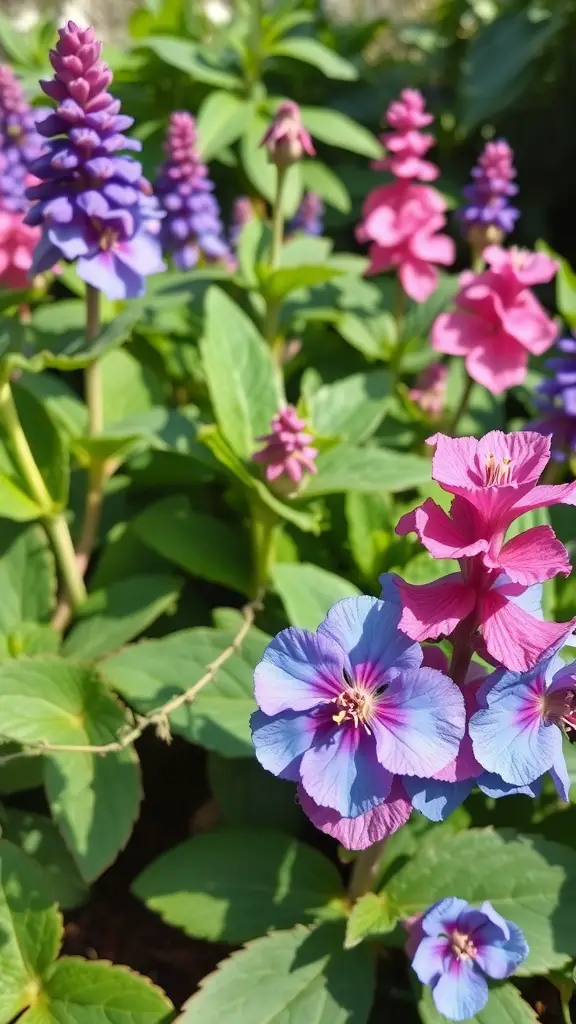
Pulmonaria, commonly known as lungwort, is a charming addition to any shade garden. This perennial plant is one of the first to bloom in spring, showcasing lovely clusters of flowers that brighten up the garden after a long winter.
In the image, you can see vibrant blue and pink flowers standing tall among lush green leaves. The delicate petals create a pleasing contrast, making pulmonaria a delightful sight in early spring. These blooms not only enhance the beauty of your garden but also attract bees and other pollinators.
This plant thrives in partial to full shade, making it an excellent choice for those tricky spots where sunlight struggles to reach. Plus, it’s relatively easy to care for, needing only well-drained soil and a bit of moisture.
As the flowers fade, the foliage remains attractive throughout the growing season, providing interest even after the blooms have passed. With its unique blend of colors and adaptability, pulmonaria is truly a gem for shade gardeners.
Columbine: Unique Flower Shapes

Columbine flowers are known for their unique and diverse shapes, making them a standout in any shade garden. With their striking petals and vibrant colors, these flowers can really add interest to your outdoor space. The image captures a beautiful cluster of columbine blooms, showcasing their delicate nature and variety of colors.
The flowers often feature a combination of pink and white hues, which creates a delightful contrast against their green foliage. This colorful display not only attracts attention but also draws in pollinators like bees and hummingbirds, which love to visit their nectar-rich blossoms. Incorporating columbine in your garden can help create a lively and dynamic environment.
In addition to their beauty, columbine plants are relatively easy to care for. They thrive in partial shade, making them a perfect choice for those tricky spots in your garden that don’t get full sunlight. Their unique flower shapes can complement other shade-loving plants, enhancing your garden’s overall aesthetic.
Bleeding Heart: Romantic Flowering Plants

The Bleeding Heart is a plant that captures attention with its unique heart-shaped flowers. These blooms dangle gracefully from arching stems, making them a striking addition to any garden.
In the image, you can see a beautiful arrangement of pink and white flowers clustered together. The soft colors and delicate shapes create a romantic vibe, perfect for garden lovers. The leaves surrounding the flowers add a lush backdrop, enhancing the overall charm of the plant.
These plants thrive in shady areas, making them ideal for those tricky spots in your garden where sunlight is limited. With their unique appearance, Bleeding Hearts can bring a touch of whimsy to any landscape.
They not only look lovely but also attract pollinators like bees, adding life to your garden. If you’re considering planting them, remember they prefer moist soil and benefit from a layer of mulch to retain moisture.
Tradescantia: Colorful and Resilient

Tradescantia, often called spiderwort, adds a splash of color to any shady garden. The bright purple and green leaves create a lovely contrast that catches the eye. These plants thrive even in lower light conditions, making them ideal for those tricky spots in your garden.
One of the best things about Tradescantia is its resilience. It’s a low-maintenance plant that can tolerate a variety of conditions. Whether you have moist soil or a bit of drought, this plant can adapt quite well. Just ensure it gets enough water, and it will reward you with vibrant foliage.
Not only does Tradescantia look great, but it also attracts butterflies and other pollinators. Its colorful flowers add an extra layer of charm, bringing life to your garden. With its hardy nature and stunning appearance, Tradescantia is a fantastic choice for anyone looking to brighten up their shade garden.
Solomon’s Seal: Graceful Arching Stems
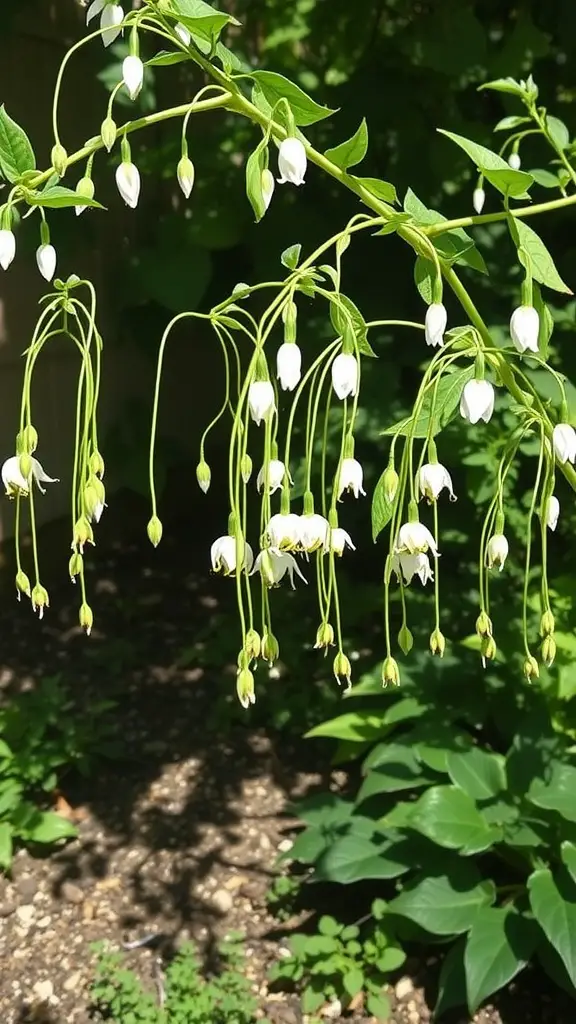
Solomon’s Seal is a delightful plant that adds a touch of elegance to any shaded garden. The image captures its graceful arching stems, which elegantly bend under the weight of delicate white flowers. These flowers hang in clusters, creating a soft and flowing look that can brighten even the shadiest corners of your garden.
The leaves are lush and green, providing a lovely backdrop to the white blooms. The overall effect is serene and calming, making it an ideal choice for a tranquil garden space. Solomon’s Seal thrives in partial to full shade, making it perfect for those tricky spots where sunlight doesn’t reach.
In addition to its beauty, this plant is quite resilient. Once established, it requires minimal care. Just ensure it has well-drained soil, and it will reward you with its stunning appearance year after year. Consider adding Solomon’s Seal to your shade garden for a blend of grace and ease.
Hellebores: Winter-Blooming Beauties

Hellebores, often known as Lenten roses, bring a burst of color to gardens during the darker months. They bloom in a variety of shades, often showing off their unique patterns and rich hues. The image captures a lovely cluster of Hellebores, showcasing their elegant petals that feature striking stripes of pink and white.
These perennial plants thrive in shady spots, making them ideal for those tricky areas in your garden where sunlight is limited. Hellebores not only add visual interest, but they also attract pollinators when little else is in bloom. The rich yellow stamens create a beautiful contrast against the soft petals, making them a delightful sight in winter gardens.
When planting Hellebores, consider their preference for well-drained soil. They are quite hardy and can withstand frost, which allows them to push through the cold ground and bloom when many other plants are still dormant. This resilience makes them a favorite among gardeners looking for reliable winter blooms.
Fuchsia: Vibrant Hanging Blooms

Fuchsia plants are a delightful addition to any shade garden. Their vibrant pink and purple blooms can instantly brighten up a space. In the image, you can see a beautiful display of fuchsia flowers cascading down from a hanging basket. The deep pink petals contrast nicely with the lush green leaves, creating a lively and inviting appearance.
These plants thrive in cooler, shaded areas, making them ideal for gardens that don’t get a lot of direct sunlight. Fuchsias are also known for attracting hummingbirds, adding an extra element of charm to your garden. They are perfect for hanging planters, where their flowers can dangle freely and create a stunning visual impact.
Taking care of fuchsia plants is quite simple. They prefer moist soil, so regular watering is essential, especially during hot weather. You can also feed them with a balanced fertilizer every few weeks to encourage even more blooms. With a little attention, these plants can flourish and provide delightful flowers throughout the summer.
Impatiens: Bright Annual Fillers
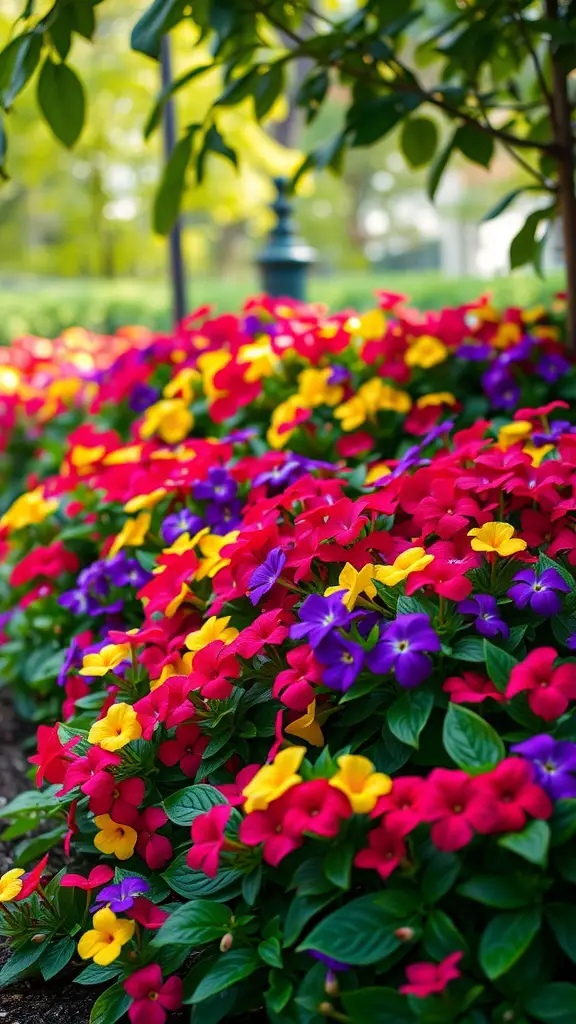
Impatiens are a fantastic choice for adding a splash of color to your shady garden spots. These annual flowers bloom in various vibrant shades, including red, yellow, and purple, as shown in the image. When grouped together, they create a lively carpet of color that can brighten even the dullest corners of your yard.
These plants thrive in areas with partial to full shade, making them ideal for those tricky spots under trees or near buildings where other flowers might struggle. They require consistent moisture and a bit of protection from harsh sunlight, but the reward is well worth the effort.
In addition to their beauty, impatiens are quite versatile. You can use them in flower beds, hanging baskets, or even as border plants to frame your garden. Their ability to bloom all summer long ensures that your outdoor space remains colorful and inviting.
Begonias: Versatile Container Plants

Begonias are a delightful addition to any garden, especially in containers. Their vibrant blooms and lush leaves make them stand out, just like the ones in the image above. The pink flowers contrast beautifully with the deep green foliage, creating a cheerful atmosphere.
These plants thrive in shaded areas, making them perfect for spots that don’t get a lot of sunlight. They are easy to care for and can flourish in pots, hanging baskets, or garden beds. The decorative pot shown in the image adds an extra touch of elegance, enhancing the overall look of your outdoor space.
When selecting begonias, consider their variety. Some have striking leaf patterns while others boast brightly colored flowers. This versatility allows you to mix and match different types for a personal touch. Be sure to provide them with well-drained soil and regular watering to keep them healthy and happy.
In summary, begonias are a fantastic choice for those looking to add a splash of color to their shade gardens. With their ease of care and beautiful appearance, they can truly brighten up your garden or patio.
Creeping Jenny: Ground Cover Charm

Creeping Jenny, known for its vibrant yellow and green leaves, is a delightful addition to any garden. This plant spreads easily, making it an excellent choice for ground cover. In the image, you can see a lush carpet of Creeping Jenny, showcasing its bright foliage under the sun.
The unique colors of Creeping Jenny can really brighten up shaded areas. It thrives in partial to full shade, which makes it a favorite for those tricky spots in the garden where other plants may struggle. This plant not only looks good but also helps prevent weeds from taking over.
Another perk of Creeping Jenny is its low maintenance needs. Once established, it requires minimal watering and can tolerate a range of soil types. Just a little trimming in the spring keeps it looking tidy and encourages fresh growth.
If you’re looking for a plant that adds charm with ease, Creeping Jenny might just be your go-to option. Whether you want to create beautiful borders or fill in bare spots, this ground cover does the job beautifully.
Sweet Woodruff: Fragrant Ground Cover

Sweet Woodruff is a charming addition to any shade garden. This low-growing plant thrives in cool, shaded areas, making it a perfect choice for those tricky spots in your yard. The lush green leaves form a thick carpet that feels soft underfoot.
In spring, Sweet Woodruff blooms tiny white flowers that bring a delicate touch to the garden. These flowers not only look lovely but also fill the air with a sweet, fresh fragrance. Imagine walking through your garden and being greeted by this pleasant scent!
This plant is not just pretty; it also helps to suppress weeds, giving your other plants a better chance to thrive. Plus, it’s a hardy perennial, which means it will come back year after year, providing consistent beauty with minimal effort.
If you’re thinking of adding Sweet Woodruff to your garden, it’s easy to care for. Just make sure it has enough moisture and partial shade, and you’re good to go. This plant is a fantastic choice for homeowners looking to enhance their shade garden with minimal fuss.
Foxglove: Tall and Elegant Spires
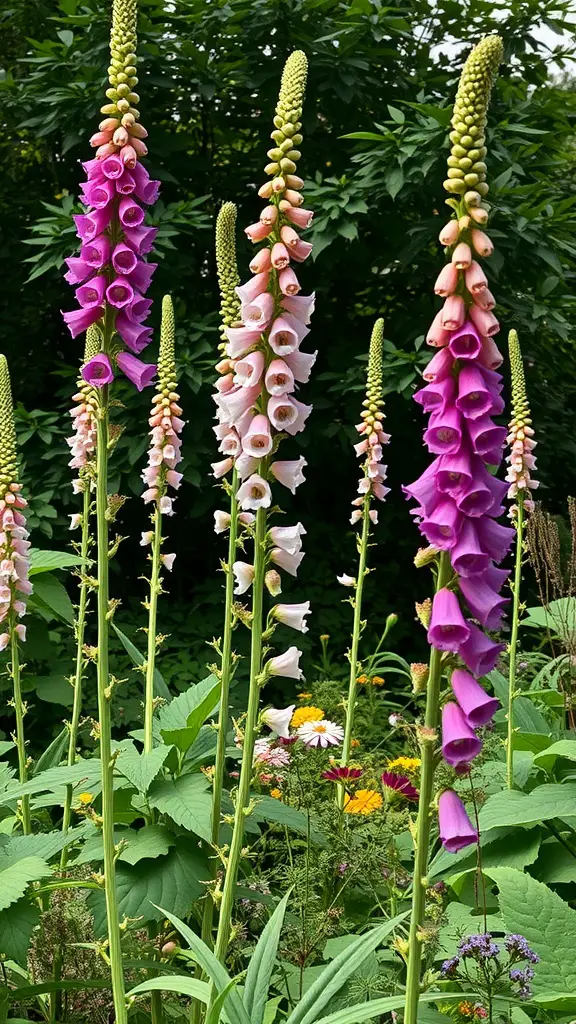
Foxgloves are truly a sight to behold in any garden. Their tall, spiky flowers rise majestically, showcasing a blend of colors that can brighten up any shaded area. In the image, you can see vibrant purple and soft pink blooms standing tall amidst greenery.
These plants thrive in partial to full shade, making them perfect for those tricky spots where sunlight is limited. Their unique tubular flowers attract a variety of pollinators, adding life to your garden.
Foxgloves are not just beautiful; they are also easy to care for. They prefer moist soil and can tolerate a range of conditions. Just be sure to keep an eye on watering, especially in dry spells.
When planting, consider pairing them with other shade-loving plants to create a colorful tapestry. Their height adds depth to your garden, making them stand out among shorter blooms.
Lily of the Valley: Delicate Fragrance

Lily of the Valley, with its charming white blooms, brings a touch of elegance to any shade garden. These lovely flowers, often found in clusters, are known for their sweet, delicate fragrance that can fill your garden with a pleasant aroma.
Growing in shady spots, they thrive under trees or in areas where sunlight is limited. Their lush green leaves add a vibrant backdrop, making the flowers stand out beautifully. Plus, these plants are relatively low-maintenance, making them a popular choice for gardeners looking for reliable shade options.
As they bloom in spring, Lily of the Valley can be a delightful surprise after a long winter. The tiny, bell-shaped flowers are not only pretty but also attract pollinators, enhancing the ecosystem in your garden. Just be cautious, as all parts of the plant are toxic if ingested!
Pulmonaria: Early Bloomers in Shade

Pulmonaria, commonly known as lungwort, is a delightful plant for shaded areas in your garden. The image showcases two vibrant flowers standing tall among lush green leaves. These early bloomers are perfect for adding a splash of color to those darker corners of your yard.
The flowers have a unique pattern with a mix of purple and white, making them quite eye-catching. The surrounding foliage is equally appealing, featuring bright green leaves that often have distinctive spots. This combination not only adds beauty but also provides a lovely contrast in texture.
Pulmonaria thrives in moist, shaded environments, which makes them great companions for other shade-loving plants. When planning your shade garden, consider these lovely plants to bring life and color to areas where sunlight is limited. They bloom early in the season, often before many other plants, making them a delightful surprise as spring arrives.
In addition to their beauty, Pulmonaria is also known for its ability to attract pollinators. This is a bonus for anyone looking to create a thriving ecosystem in their garden. Whether you’re a seasoned gardener or just starting out, Pulmonaria can be a charming addition to your shaded spaces.
Corydalis: Unique Blue Flowers

Corydalis is a charming plant that stands out with its unique blue flowers. These delicate blossoms create a lovely contrast against the rich greenery of the garden. You can see multiple spikes of these flowers, each showcasing a gentle hue that can brighten up any shaded area.
These plants thrive in cooler, shaded locations, making them a perfect addition to your 34shade garden. They not only add color but also provide a unique texture with their upright stems and intricate flower shapes. The soft blue of the flowers can complement other shade-loving plants beautifully.
Growing Corydalis is quite simple. They prefer moist, well-drained soil and can often spread easily, filling in bare spots in your garden. This means less maintenance for you, allowing you to enjoy their beauty with minimal effort.
So, if you’re looking to enhance your garden with something a bit different, consider Corydalis. Their gentle blue flowers are sure to catch the eye and bring a sense of tranquility to your outdoor space.
Acanthus: Bold Architectural Foliage
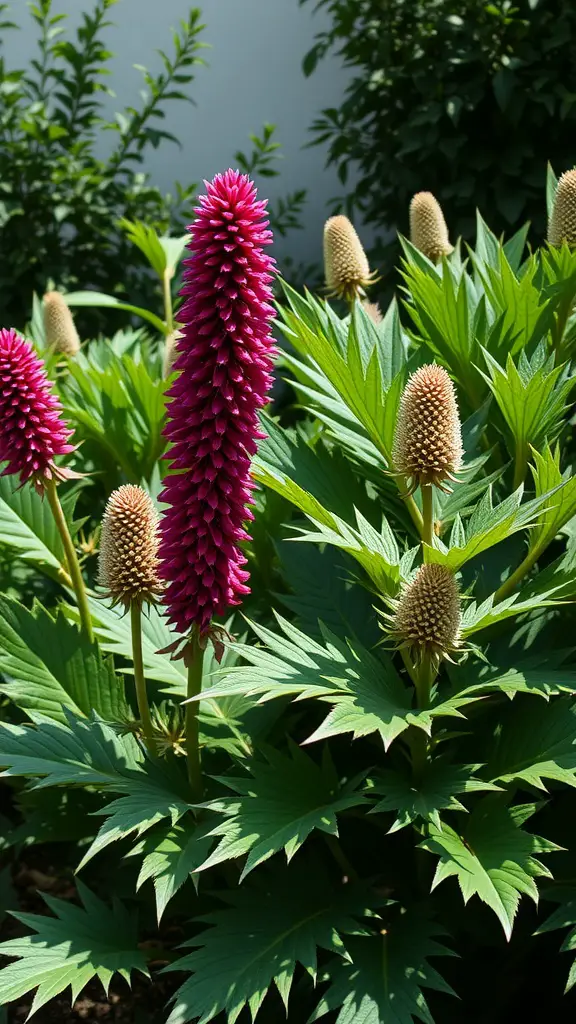
The Acanthus plant is a real standout in any shade garden. It features large, striking leaves that create a bold backdrop for your other plants. The leaves have a distinct shape that adds texture and depth to your garden. When you see them together, they form a lush green carpet that feels both wild and curated.
One of the most eye-catching aspects of the Acanthus is its unique flower spikes. These tall, spiky blooms can range from white to deep purple, adding a pop of color that draws the eye. The flowers stand proudly above the foliage, making them a focal point in your garden. It’s a lovely contrast to the broad leaves beneath.
Besides their looks, Acanthus plants are quite hardy. They thrive in partial to full shade and can tolerate a variety of soil types. This makes them suitable for different garden conditions. As they grow, they can spread out, filling in empty spaces with their lush foliage.
If you’re considering adding Acanthus to your garden, they pair well with other shade-loving plants. Their architectural style complements more delicate flowers and softer textures. This creates a layered look that’s pleasing to the eye. Overall, Acanthus adds a dramatic touch to any garden, making it a fantastic choice for those looking to elevate their shaded spaces.
Toad Lily: Exotic, Spotted Flowers
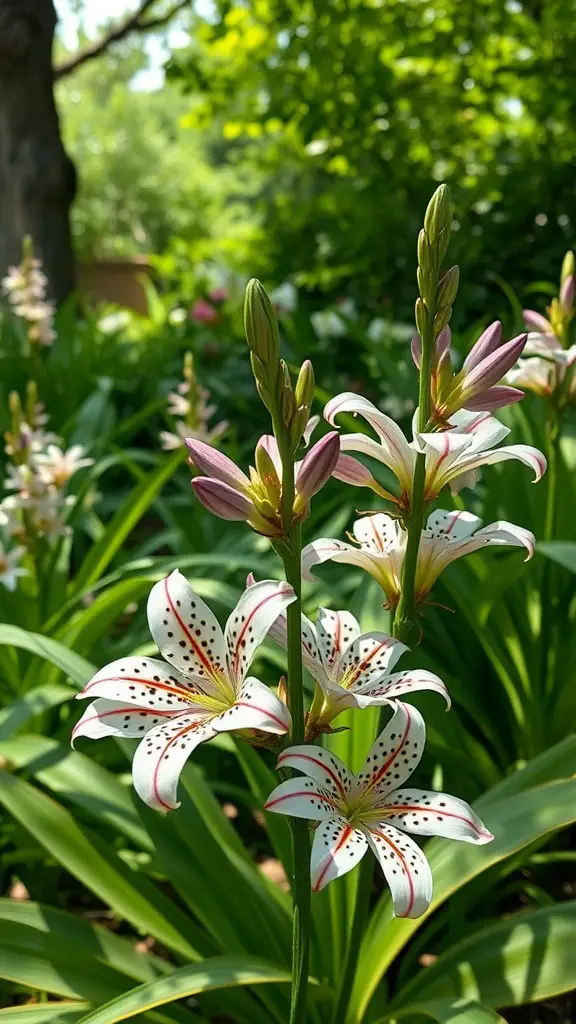
Toad lilies, or Tricyrtis, bring a touch of the exotic to any shade garden. Their unique spotted flowers instantly catch the eye. In the image, you can see clusters of these beautiful blooms, each with delicate petals that showcase a pattern of purple spots against creamy white.
These plants thrive in shady spots, making them ideal for gardens with limited sunlight. The lush green foliage provides a lovely backdrop for the flowers. As you explore a garden featuring toad lilies, you’ll notice how their intricate details invite closer inspection.
Toad lilies typically bloom in late summer to early fall, adding color when many other perennials are winding down. They are low-maintenance and can adapt well to different soil types, making them a favorite among gardeners. If you’re considering adding a touch of charm to your garden, these spotted wonders might just be the perfect choice!
Cyclamen: Charming Winter Blooms

Cyclamen are delightful little plants that bring a splash of color during the cold months. Their pink blooms rise gracefully above the lush green leaves, creating a cheerful scene. The image captures a vibrant cluster of cyclamen, showcasing their charming flowers, which can brighten up any shady garden.
These plants are known for their unique heart-shaped leaves, which add texture to the garden even when the flowers are not in full bloom. The subtle variation in shades of pink among the flowers makes them visually appealing. They thrive in well-draining soil and prefer cooler temperatures, making them a perfect choice for winter gardens.
When planting cyclamen, it’s important to choose a location that offers some protection from harsh sunlight. This helps maintain their delicate blooms and encourages a longer flowering period. They are also relatively low maintenance, needing only occasional watering and a bit of compost to keep them healthy. With the right care, cyclamen can flourish, providing color and charm throughout the winter months.
Epimedium: Drought-Resistant Ground Covers

Epimedium, often called barrenwort, is a delightful addition to any garden, especially in shaded areas. The image captures a lush patch of Epimedium, showcasing its unique heart-shaped leaves. These plants are not just pretty; they are also drought-resistant, making them a practical choice for gardeners.
The vibrant green leaves, with some displaying a deep, rich purple hue, add a lovely contrast to the garden floor. This diversity in color creates visual interest and can brighten up darker corners of your yard. What’s more, Epimedium thrives in less-than-ideal conditions, such as dry shade, which can be a challenge for many other plants.
These ground covers are perfect for preventing soil erosion, especially on slopes. They spread easily, filling in gaps and creating a soft, carpet-like appearance. Plus, their flowers, although small, attract pollinators, adding life to your garden.
Overall, incorporating Epimedium into your landscape is a smart choice. It’s not just about aesthetics; it’s also about choosing resilient plants that can withstand the elements while providing a beautiful ground cover.
Japanese Forest Grass: Graceful Foliage

Japanese Forest Grass, known for its elegant appearance, adds a touch of softness to any shaded garden. The image shows lush, arching blades that sway gently in the breeze. This grass is perfect for creating a serene atmosphere in your outdoor space.
The foliage features a stunning mix of bright green with yellow highlights, creating a lively contrast against darker backgrounds. This vibrant coloration helps to brighten shaded areas, making it a lovely choice for gardens that receive limited sunlight.
Growing well in partial to full shade, Japanese Forest Grass thrives in moist, well-drained soil. It’s a low-maintenance option that requires little care once established. Just a bit of regular watering and occasional trimming will keep it looking its best.
This grass also pairs beautifully with other shade-loving plants, such as ferns or hostas. Consider planting it in clusters for added visual impact or as ground cover to prevent weeds.
Pulmonaria: Low-Maintenance Ground Covers

Pulmonaria, commonly known as lungwort, is a delightful addition to any shaded garden. The image showcases its beautiful pink flowers, which stand tall among lush green leaves. These flowers bloom in early spring and provide a pop of color that can brighten up any dim corner of your yard.
What makes Pulmonaria especially appealing is its low-maintenance nature. Once established, it requires minimal care, making it perfect for gardeners who prefer a hands-off approach. It thrives in moist, well-drained soil and can tolerate various light conditions, though it does best in partial shade.
This plant also plays a beneficial role in the garden ecosystem. It attracts early pollinators like bees and butterflies, which is a boon for biodiversity. The foliage is equally attractive, often featuring unique spotting or variegation, adding texture to the garden floor.
Incorporating Pulmonaria into your landscape design can create a lush ground cover that suppresses weeds and enhances the overall aesthetic. Whether planted in clusters or as a border, it provides a natural, effortless beauty that complements a variety of other shade-loving plants.
Lobelia: Vibrant Blues for Shade

Lobelia is a delightful addition to any shade garden. Its vibrant blue flowers catch the eye and add a splash of color to shady spots often overlooked.
In this image, you can see clusters of striking blue lobelia blooms. Their unique star-shaped petals create a charming display, making them perfect for borders or mass plantings.
Lobelia thrives in moist, well-drained soil and prefers partial to full shade, which makes it a great option for those tricky areas in your garden.
Not only do these plants look good, but they also attract pollinators like butterflies, enhancing the overall garden ecosystem.
When planting lobelia, be sure to space them out to allow for good air circulation, which helps prevent mold and mildew. With proper care, these beauties can bloom from spring until the first frost!
Siberian Bugloss: Hardy Ground Cover

Siberian Bugloss, also known as Brunnera macrophylla, is a charming addition to any shaded garden. The lush green leaves create a lovely backdrop for its striking blue flowers. In the image, you can see clusters of delicate blue blooms that stand tall above the vibrant foliage.
This plant thrives in shady areas, making it a perfect choice for spots where many other plants struggle. The round, heart-shaped leaves are not only attractive, but they also help in suppressing weeds, allowing Siberian Bugloss to act as an effective ground cover.
Besides its aesthetic beauty, it is quite low-maintenance. Just a little water and occasional fertilization are enough to keep it thriving. You’ll find that it attracts bees and butterflies, adding life to your garden.
With its hardy nature, Siberian Bugloss can handle a variety of soil types, although it prefers moist, well-draining conditions. This resilience makes it a great option for anyone looking to fill up those shady spots with something that looks nice and requires minimal fuss.
Bluebells: Classic Spring Blooms
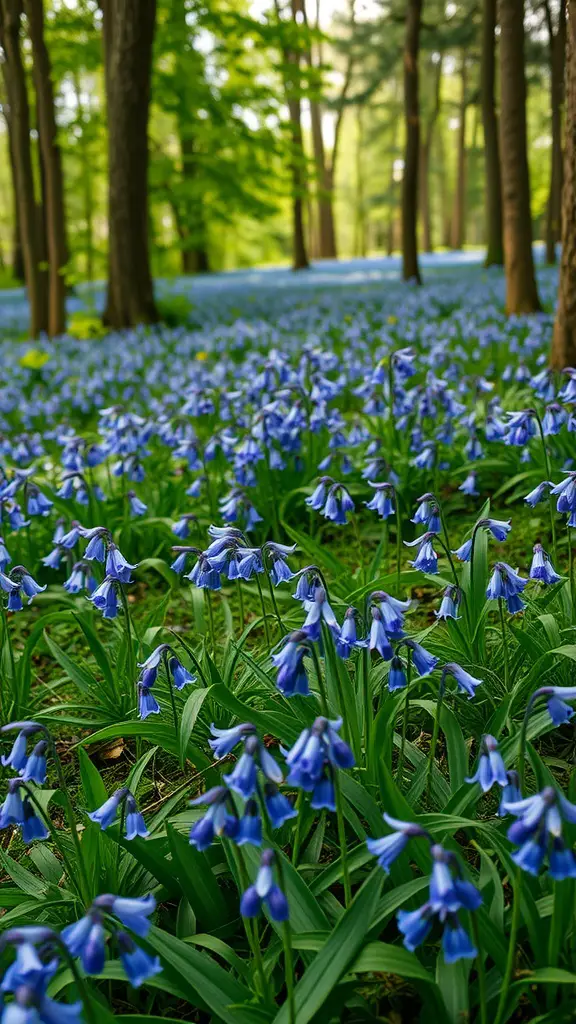
Bluebells are a delightful sign that spring has arrived. In the image, you can see a forest floor blanketed with these charming flowers. Their soft, bell-shaped blooms create a sea of blue, contrasting beautifully with the fresh green leaves around them.
These plants thrive in shady areas, making them perfect for gardens that don’t get a lot of direct sunlight. Bluebells are native to Europe and often bloom from April to May, bringing a splash of color as the weather warms up. They are easy to grow and can spread quickly, forming lovely carpets that enhance any garden space.
One fun fact about bluebells is that they are often associated with woodlands. When you walk through a forest filled with them, it feels like stepping into a fairy tale. They also attract various pollinators, including bees, which enjoy their sweet nectar.
To keep your bluebells healthy, be sure to plant them in well-drained soil. They prefer a bit of moisture but don’t like to sit in water. Once they bloom, resist the urge to cut them back right away. Allow the leaves to die back naturally; this helps the plant gather energy for next year’s growth.
In summary, bluebells are not just beautiful but also beneficial for your garden. They bring life to shaded spaces and support local wildlife. If you’re looking for a classic spring bloom that requires minimal effort, bluebells are a great choice.
Shade-Tolerant Roses: Blooming in the Shadows

Roses often bring to mind bright sunshine, but some varieties can thrive even in shady spots. The image showcases a lovely cluster of pink roses, basking in a gentle light, surrounded by lush green foliage. These blooms add charm and color to any garden, especially in areas where sunlight is limited.
When selecting shade-tolerant roses, look for varieties like ‘Knock Out’ or ‘Mister Lincoln.’ These plants are known for their resilience and ability to bloom beautifully, even with minimal direct sunlight. The pink hues in the image highlight how vibrant and inviting these flowers can be, even in less-than-ideal lighting.
Proper care is essential for growing roses in the shade. Ensure they receive enough water and consider adding mulch to retain moisture. With a little attention, these roses can transform your shaded areas into a delightful retreat filled with color and fragrance.
Woodland Phlox: Colorful Ground Cover
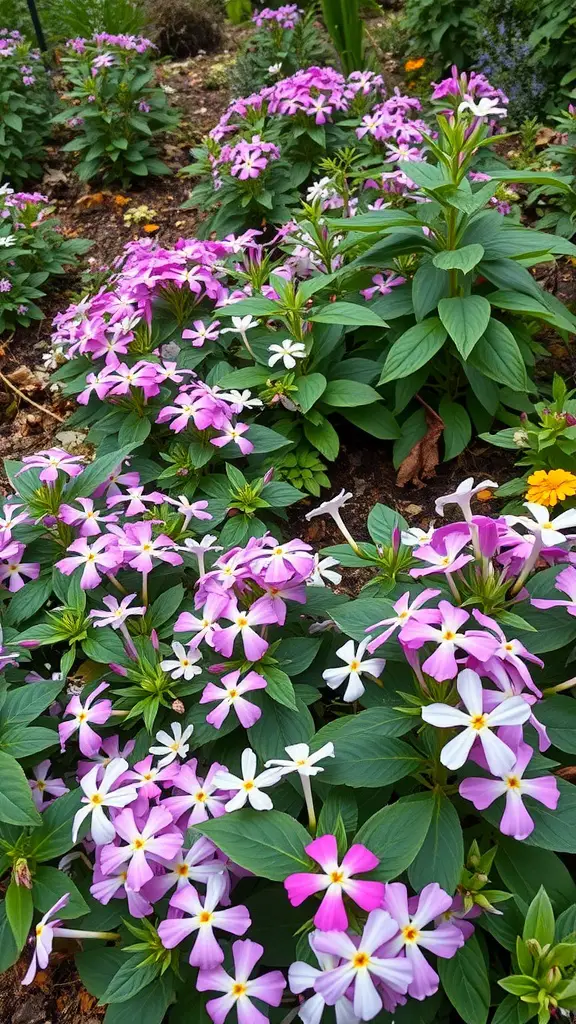
Woodland phlox is a delightful addition to any garden, especially in shaded areas. The image showcases vibrant clusters of pink and white flowers, which create a cheerful blanket of color. These flowers bloom in spring and can bring life to your garden as they spread gracefully across the ground.
Not only do they look charming, but woodland phlox also serves an important purpose as a ground cover. Their ability to thrive in low-light conditions makes them perfect for those tricky spots where sunlight struggles to reach. The lush green leaves provide a nice contrast to the colorful blooms, making them visually appealing.
If you’re thinking about adding woodland phlox to your garden, consider planting them in well-drained soil with some organic matter. They appreciate a bit of moisture but are not fond of soggy conditions. Group them in clusters for a more natural look, and watch as they attract butterflies and other pollinators!


Hi to every body, it’s my first pay a visit of this blog; this web site consists of remarkable and really fine data for readers.
casino en ligne
Good web site you’ve got here.. It’s hard to find good quality writing like yours nowadays.
I really appreciate people like you! Take care!!
casino en ligne
magnificent issues altogether, you simply received a new reader.
What may you recommend in regards to your post that you simply
made a few days ago? Any certain?
casino en ligne francais
you are really a good webmaster. The site loading velocity is amazing.
It seems that you’re doing any unique trick.
Furthermore, The contents are masterpiece. you have performed a wonderful job in this subject!
casino en ligne France
This is my first time visit at here and i am in fact impressed to read all at single place.
casino en ligne
Pretty section of content. I just stumbled upon your website and in accession capital to assert
that I acquire actually enjoyed account your blog
posts. Any way I’ll be subscribing to your feeds and even I achievement you access consistently quickly.
casino en ligne
Hi! Do you know if they make any plugins to safeguard against hackers?
I’m kinda paranoid about losing everything I’ve worked hard on. Any
tips?
casino en ligne fiable
I’m really enjoying the design and layout of your website.
It’s a very easy on the eyes which makes it much more enjoyable for
me to come here and visit more often. Did you hire out a designer to create your theme?
Superb work!
casino en ligne
I love your blog.. very nice colors & theme. Did you
design this website yourself or did you hire someone to
do it for you? Plz answer back as I’m looking to create my own blog and would like to find out where u got
this from. appreciate it
casino en ligne
Hey would you mind letting me know which webhost
you’re utilizing? I’ve loaded your blog in 3 different internet browsers and I
must say this blog loads a lot faster then most. Can you recommend a good hosting
provider at a reasonable price? Thank you, I appreciate
it!
meilleur casino en ligne